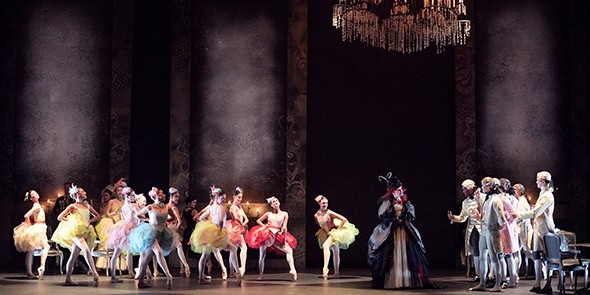English National Ballet’s Le Corsaire at London Coliseum
Posted: January 11th, 2020 | Author: Nicholas Minns | Filed under: Performance | Tags: Anna-Marie Holmes, Daniel McCormick, Emma Hawes, English National Ballet, Erina Takahashi, Francesco Gabriele Frola, Gavin Sutherland, Henry Dowden, Junor Souza, Katja Khaniukova, Lars Payne, Le Corsaire, Lord Byron, Michael Coleman, Neil Austin | Comments Off on English National Ballet’s Le Corsaire at London ColiseumEnglish National Ballet, Le Corsaire, London Coliseum, January 9

Handsome pirates and beautiful slave girls are the stuff of classic Hollywood films, where sensual aesthetics and genteel bravado were the prime movers of the plot and the prime interest in seeing them. Byron’s poem of 1814, The Corsair is a forerunner of this kind of blockbuster myth making, while Byron’s life might serve as its primary source. Anna-Marie Holmes’ production of Le Corsaire for English National Ballet, recreated from the ballet of Marius Petipa as notated by Stepanov in the collection of Konstantin Sergeyev, could well be a portrait of the passionate life, loves and political causes of Byron himself: a flamboyant adventure story, a stage full of virile men and exotic women, a deferential slave and a satirical portrait of a licentious Pasha. That the plot of the ballet and that of the poem diverge on so many details except the geography and names is the fault of the libretto for the 1856 Paris Opéra production of Le Corsaire by Julies-Henri de Saint-Georges and Joseph Mazilier. Subsequent productions in Russia by Jules Perrot and Petipa maintained the outline of the plot while revising the choreography, but as Jane Pritchard points out in the program, the provenance of this production gets more complicated. The well-known Le Corsaire pas de deux is neither Perrot nor Petipa but is based on a 1915 pas d’action by the St. Petersburg dancer (and teacher of the young George Balanchine), Samuil Andrianov. Like the life of Byron, this ENB production of Le Corsaire is a rich synthesis of influences.
Bob Ringwood’s sets and costumes effortlessly bridge the poles of Hollywood cinema and Byron’s Ottoman exploits with dreamy textures, colours and vistas — including a wonderfully romantic vignette of a front curtain and a smokingly erotic opium apparition in the Dream section — while the composite score, tirelessly excavated from the work of ten composers by ENB Philharmonic’s music librarian and cellist, Lars Payne, and seamlessly reconstructed by conductor Gavin Sutherland, embraces the range of emotions that unfold on stage. Nothing would be seen without Neil Austin’s lighting which not only enhances the textures of Ringwood’s stage but highlights the narrative with its own arsenal of dramatic effects.
This rich tapestry, however, is not unproblematic. In fact, how are we to approach Le Corsaire? Its orientalism is evident because the ballet is riddled with cultural tropes and stereotypes; we cannot change the attitude of a historical work, but it can certainly illuminate our current references. One might take issue with Holmes’ decision to turn the character of the Pasha from Byron’s villain (as portrayed in Russian productions) to Michael Coleman’s portrayal of a ‘doddery old, fat fool’ to balance the drama with some lightness; the balancing works, but the characterisation is gratuitous. Wherever the Pasha is involved, the ballet turns into a pantomime, but Coleman plays up his role so well that our enjoyment makes us oblivious of our own attitudes towards ‘the other’.
Slavery is also an issue that looms large in a contemporary viewing of Le Corsaire; although it continues to play an insidious part in our society, its treatment in Le Corsaire masquerades as the objectification of women. While the male characters are involved in adventurous exploits, the female roles are featured choreographically as forced auditions for the Pasha’s harem or as apparitions in his opium dreams; while the women are on show, the men are showing off.
What remains beyond the cultural and ethical considerations of the ballet is the impressive quality of ENB’s dancing. Due to illness, this evening’s principals Erina Takahashi as Medora and Francesco Gabriele Frola as Conrad had been called on to replace Alina Cojocaru and Isaac Hernandez on the opening night. Having also danced the dress rehearsal, the additional strain of a second consecutive night shows through at times, but Takahashi’s exquisite refinement and Frola’s expansive enthusiasm create a convincing rapport. Daniel McCormick, in serene and impeccable form as Conrad’s loyal slave, Ali, brings the house down in the second act pas d’action and Junor Souza’s effusive energy as the slave trader Lankendem extends to his spontaneous mime; the other men could learn from his clarity. The lyrical Emma Hawes is a melancholy Gulnare for whom the impetuous Henry Dowden as Birbantio takes a shine, and the steely self-confidence of Katja Khaniukova shines in her odalisque variation. Continuing its run until January 14, there are still plenty of opportunities to appreciate the myriad details of the production and the diverse qualities of subsequent casts.
